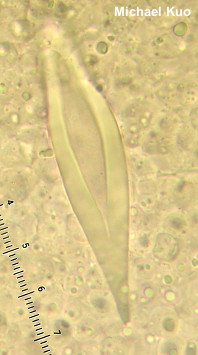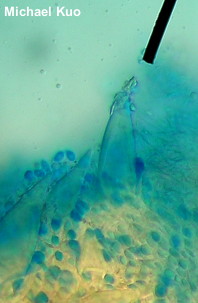| Major Groups > Gilled Mushrooms > Pale-Spored > Pleurotoid Mushrooms > Hohenbuehelia > Hohenbuehelia petaloides |
| Major Groups > Gilled Mushrooms > Saw-Gilled Mushrooms > Hohenbuehelia petaloides |

|
Hohenbuehelia petaloides [ Basidiomycota > Agaricales > Pleurotaceae > Hohenbuehelia ... ] by Michael Kuo Hohenbuehelia petaloides is distinctively shaped; its "petaloid" habit often makes it look like a shoehorn with gills, or a rolled-up funnel. Other identifying features include its fairly crowded whitish gills, a white spore print, mealy odor and taste—and, under the microscope, gorgeous "metuloids" (thick-walled pleurocystidia). It often appears in clusters in urban, semi-urban, or even household settings, and is frequently associated with woody debris (though it does not usually grow directly from dead wood) or cultivated soil. However, it can be found in woodland settings, too, where it tends to grow alone or in small groups. Lentinellus cochleatus can appear very similar, but it grows directly from logs and stumps, and features more conspicuously serrated gill edges; additionally, its microscopic details are very different. Hohenbuehelia geogenia is a synonym; Hohenbuehelia "petalodes" (without the i) is an alternate spelling. Thanks to Betty Shearer for collecting, documenting, and preserving Hohenbuehelia petaloides for study; her collection is deposited in The Herbarium of Michael Kuo. Description: Ecology: Saprobic; growing alone, gregariously, or in clusters; terrestrial; often in the vicinity of woody debris; often found in gardens, parks, lawns (etc.), or even potted plants—but also found in woods; summer and fall (or over winter in warmer climates); widely distributed in North America. The illustrated and described collections are from Illinois, Kentucky, and California. Cap: 3–9 cm across; usually shoehorn-shaped, or rolled into a funnel shape—but sometimes fan-shaped and lobed; sticky to moist when fresh; fairly bald, but sometimes with fine white fuzz in places; dark brown to grayish brown at first, fading to pale yellowish brown or beige, often with a darker central area; the margin not lined. Gills: Running deeply down the stem; crowded; short-gills frequent; whitish, becoming dull yellowish. Stem: Present but hard to define precisely, since it is continuous with the cap; 1–3 cm high; 3–10 mm thick; brownish to whitish; bald, or fuzzy over the lower half; basal mycelium white. Flesh: Whitish; rubbery; unchanging when sliced. Odor and Taste: Mealy. Chemical Reactions: KOH on cap surface negative. Spore Print: White. Microscopic Features: Spores 5–9 (-10) x 3–4.5 µm; ellipsoid; apiculus prominent; smooth; hyaline in KOH; inamyloid. Cheilocystidia fusoid to lecythiform, capitate, or irregular; to about 35 x 8 µm. Pleurocystidia ("metuloids") abundant; lanceolate to fusoid; 35–100 x 7.5–20 µm; with very thick walls; smooth but sometimes developing apical encrustations (sometimes hard to see in KOH mounts but visible in lactophenol and cotton blue); hyaline with ochraceous walls in KOH. Pileipellis a thin cutis-like tangle of elements 2.5–7.5 µm wide, with scattered, embedded pileocystidia above a thick zone of gelatinized hyphae. Clamp connections present. REFERENCES: (Bulliard, 1780) Schulzer, 1866. (Fries, 1821; Saccardo, 1887; Kauffman, 1918 [Pleurotus spathulatus]; Arora, 1986; Thorn & Barron, 1986; Breitenbach & Kränzlin, 1991; Lincoff, 1992; Metzler & Metzler, 1992; Roody, 2003; Kuo & Methven, 2014; Desjardin, Wood & Stevens, 2015; Siegel & Schwarz, 2016.) Herb. Kuo 05280707, 06251103, 10041510, 07061601, 07181614. This site contains no information about the edibility or toxicity of mushrooms. |
© MushroomExpert.Com |
|
Cite this page as: Kuo, M. (2016, August). Hohenbuehelia petaloides. Retrieved from the MushroomExpert.Com Web site: http://www.mushroomexpert.com/hohenbuehelia_petaloides.html |







